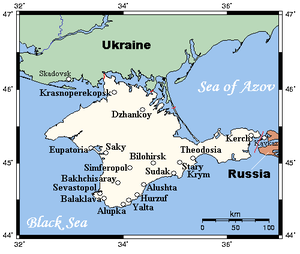In a landmark vote today, Crimea’s parliament has formally declared its independence from the Ukraine, extending its de facto autonomy to outright secession, and changing its name to the Republic of Crimea.
 Crimean independence isn’t going to last though, as the Sunday referendum takes independence as a starting point but provides only two options, either of which will end that status.
Crimean independence isn’t going to last though, as the Sunday referendum takes independence as a starting point but provides only two options, either of which will end that status.
Voters will be asked to choose between reunification with the Russian Federation or restoring the 1992 Constitution and Crimea’s status as a part of the Ukraine. There is no option to reject both possibilities and support remaining independent.
Physically, an independent Crimea is roughly the size of Israel or Kuwait, but its population is much smaller, more in line with a nation like Latvia or Estonia.
This is the first time Crimea has been independent since 1783, when it was annexed into the Russian Empire. It remained part of Russia (and the Russian Soviet Socialist Republic during the Soviet era) until 1954, when Ukrainian-born Nikita Khrushchev transferred it into the Ukrainian Soviet Socialist Republic. It remained part of Ukraine since, albeit one with a considerable degree of autonomy.
Crimea’s population is majority ethnic-Russian, and it hosts the Russian Black Sea Fleet. Though a Russian Unity party in Crimea’s parliament has pushed for reaccession into Russia, the region’s secessionist push didn’t really get serious momentum until the recent regime change in Kiev, which ousted a pro-Russian government.


